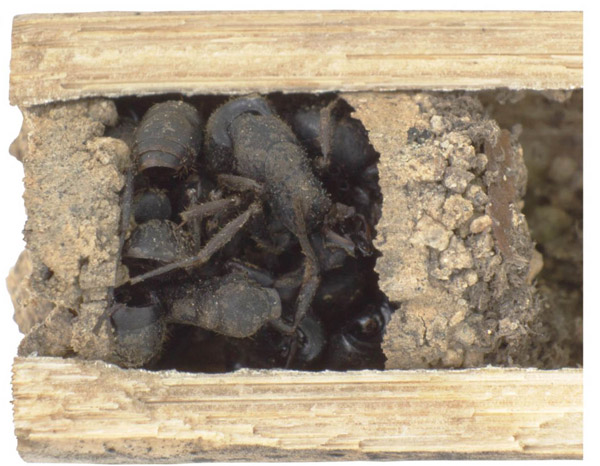New wasp builds nest out of ant corpses (Hance)
Adult female of the new wasp species, the bone-house wasp. Photo courtesy of Staab et al.
If ants made horror movies this is probably what it would look like: mounds of murdered ants sealed up in a cell. The villain of the piece—at least from the perspective of the ants—is a new species of spider wasp, which scientists have aptly dubbed the bone-house wasp (Deuteragenia ossarium) in a paper published in July in the journal PLOS ONE. But the reason it fills a nest chamber with dead ants is even more surprising: baby proofing.
"Our discovery demonstrates in an impressive way, what fascinating strategies of offspring-protection have evolved in the animal kingdom," said lead author Michael Stabb with the University of Freiburg.
Here's how this works: spider wasps (in the family Pompilidae) build large nests usually constructed out of plant debris, soil, and resin. Each nest contains several cells where the mother wasp lays her eggs. Once the nest is constructed and the eggs are laid, however, she abandons them, leaving them vulnerable to predation and parasites, such as parasitical wasps.

Close-up of the dead ant chamber. After killing the ants, the bone-house wasp encloses them in a cell. Photo courtesy of Staab et al.
But the bone-house wasp from Southeast China has done something novel, which the authors describe as "a surprising nesting behavior that was previously unknown in the entire animal kingdom." It builds a final outer layer cell around its brood in which it piles dead ants, sealing them up in a seeming bug-recreation of Poe's "The Cask of Amontillado." Yet the wasp doesn't do this out of vengeance, but to better-safeguard its nest.
A diminutive elephant-relative discovered in Namibia (Hance)

Meet the world's newest elephant shrew: the Etendeka round-eared sengi. Photo by: Jack Dumbacher/California Academy of Sciences.
Forget marsupials, the world's strangest group of mammals are actually those in the Afrotheria order. This superorder of mammals contains a motley crew that at first glance seems to have nothing in common: from the biggest land animals on the planet—elephant—to tiny, rodent sized mammals such as tenrecs, hyraxes, golden moles, and sengis. But there's more: the group even includes marine mammals, such as dugongs and manatees. Finally, they also include as a member the most evolutionary-distinct mammal on the planet: the aardvark. While these species may seem entirely unrelated—and many were long shuffled into other groups—decades of genetic and morphological research now point to them all springing from the same tree. In June 2014, though, scientists announced the newest, and arguably cutest, member of Atrotheria: the Etendeka round-eared sengi.
Described in the Journal of Mammology, the Etendeka round-eared sengi (Macroscelides micus) was discovered in the northwest corner o Namibia.
"It...might seem remarkable that Macroscelides micus escaped detection for more than 100 years since the first sengis were being described, but it occurs in a small and remote arid area that is difficult to access and has only recently been explored by small-mammal biologists," the authors of the paper write.
It is distinguished from other sengis first by its size: the new species is the smallest sengi yet recorded. Only 19 centimeters long (7.5 inches), the new mammal weighs just 28 grams (0.9 ounces), or less than a dozen U.S. pennies. Moreover, the species is distinct for a hairless gland under its tail, pink-hued skin (as opposed to dark skin), and a rusty-colored fur which helps it blend into the reddish soil of the dry Etendeka Plateau.
Biologists catalog the world's 10,000th reptile species (Hance)

Cyrtodactylus vilaphongi: the world's 10,000th reptile. Photo by: Truong Nguyen.
In July, Cyrtodactylus vilaphongi, a gecko from the forests of Laos, became the 10,000th reptile species entered into the Reptile Database, an online catalog of all the world's living reptiles.
"Officially, we have logged 10,038 reptile species into the database, which is up from 9,952 that was reported in April," said Peter Uetz, the founder and editor of the Reptile Database.
Scientists discover carnivorous water rat in Indonesia (Erickson-Davis)
 The first specimen of Waiomys mamasae ever seen by scientists. Photo by Kevin C. Rowe.
The first specimen of Waiomys mamasae ever seen by scientists. Photo by Kevin C. Rowe.
Researchers have discovered a new carnivorous water rat on the island of Sulawesi that's so unique it represents an entirely new genus. They believe many more rodent species await discovery in this relatively undisturbed part of Indonesia, but mining and other types of development may threaten vital habitat before it’s even surveyed.
Named Waiomys mamasae and described in a paper published in the journal Zootaxa, the species is known by a single animal that was caught by hand in a small stream in Western Sulawesi’s mountainous interior. Scientists were alerted to the species' existence by local people who use it as a talisman to protect their homes against fire.
